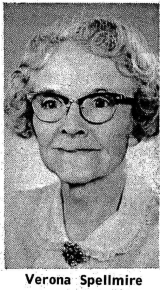The History of the Confraternity of Christian Doctrine
 The practicality of founding a branch of the Confraternity
of Christian Doctrine (CCD) in the Diocese of Monterey-Los Angeles was initially
broached by Verona Spellmire, a public school teacher long active in
catechetical work among the ever-growing community of Mexican-Americans. Father
Robert Emmet Lucey, Director of Catholic Charities, was responsive to the idea
and arranged for a series of exploratory discussions during which the need for a
local unit of the Confraternity was thoroughly studied.
The practicality of founding a branch of the Confraternity
of Christian Doctrine (CCD) in the Diocese of Monterey-Los Angeles was initially
broached by Verona Spellmire, a public school teacher long active in
catechetical work among the ever-growing community of Mexican-Americans. Father
Robert Emmet Lucey, Director of Catholic Charities, was responsive to the idea
and arranged for a series of exploratory discussions during which the need for a
local unit of the Confraternity was thoroughly studied.
Episcopal endorsement came on March 11, 1922, with Bishop John J. Cantwell’s call for an organizational meeting at which he gave his unqualified approval of the CCD. Father William J. Mullane was named director of the new unit, which closely followed the pattern of the Pittsburgh Missionary Confraternity in its activities among the immigrants scattered through the rural districts of southwestern Pennsylvania.
While the work of the CCD in Los Angeles was not restricted to Hispanic immigrants, it was among that segment of the Catholic population that its earliest and most far-reaching accomplishments were realized. The first foundation, on the parochial level, was made at Saint Mary’s Church in East Los Angeles. On April 16, 1923, a formal constitution was approved, and, shortly thereafter, the initial catechetical center was opened under the patronage of Santa Maria at Belvedere Park.
The apostolate was warmly supported by Bishop Cantwell who expressed grave concern for the “thousands of children in and around our city, especially among our immigrants, who are in danger of being lost to the faith” through lack of proper catechetical instruction. Of those heeding the prelate’s invitation for personal involvement in the CCD objectives, more than 300 completed the training course and qualified for assignment in one or another of the 12 centers in key locations of the diocese.
Further expansion came, on March 5, 1924, when the bishop lent his support to the parish unit system of organization, which he endorsed for adoption in all of Southern California. With the establishment of a Diocesan Union of Confraternities, minutely structured programs were inaugurated for teacher-training, home visitation, transportation of students and relief to the poor and needy. What began as a missionary movement on behalf of children living in the immigrant districts had blossomed into a bond of parochial confraternities.
A new phase of involvement came in the years after 1926, with the appointment of Father Leroy Callahan to the directorship. Among the first of his innovations was the affiliation of the Los Angeles branch with the Archconfraternity of Christian Doctrine in Rome. Father Callahan, a recognized scholar, initiated a series of model catechetical lessons, which were widely utilized as a pioneer handbook for CCD teachers. Within a few years, some 35 comparable publications were circulating around the country bearing the Los Angeles imprint.
In 1928, the CCD ambit was further enlarged to encompass courses for religious vacation school. The Handbook of Suggestions for the Daily Vacation School, the first compilation of its kind ever produced, was subsequently adopted by over 50 centers in the eastern and southern parts of the United States.
The planning, vitality and spirit of CCD activities in the Diocese of Los Angeles-San Diego promoted similar undertakings in other areas. Father Callahan’s hope of seeing the Confraternity established nationally was championed, in the early 1930s by Father Edwin V. O’Hara of the Catholic Rural Life Conference, who recognized the program’s merits and its relevance to the Church on the national scene.
To O’Hara, the Los Angeles plan provided a partial answer to the perplexing challenge posed by the tremendous numbers of children unable to participate directly in the already functioning Catholic school system.
There were other epoch-making proposals emanating from California’s southland such as the formation, within the CCD framework of teacher institutes and study groups to better equip member for their particular apostolate. By 1936, the Confraternity of Christian Doctrine in Los Angeles was a vital organization with an effective catechetical program reaching the largest number of public school children in the county.
The manifold accomplishments of the Confraternity of Christian Doctrine in its earliest years helped to create interest, encourage programs and upgrade instruction in CCD activities in practically every area of the nation. Eventually, a goodly portion of the country’s affiliated branches had adopted the basic guidelines used so effectively in Southern California.
By 1937, the CCD program was so widespread that it required a full-time director. Msgr. John Clarke became director, a post he held until 1970. Within his 33 years, the CCD registration of precipitants grew from 30,000 to more than 200,000 in 1969.
Source: "A History of the Archdiocese of Los Angeles" by Msgr. Francis J. Weber and contributors Hermine Lees and Sister Joanne Wittenburg, SND.
|
CONGRESS HOME PAGE |
ABOUT
CONGRESS: Order
Guidebook �
Reviews �
Themes �
Theme Reflections �
Theme Songs �
Sign Up �
Congress Chats �
Resources �
Volunteers �
For New Exhibitors �
Order Recordings �
Download Recordings �
Congress Milestones �
History in Photos �
Email Us �
Contact Us �
Privacy Policy |
|||
| 2020 CONGRESS INFO: REC 2020 � REC LIVE � YOUTH DAY � SPOTLIGHT � SCHEDULE � LITURGIES � SPEAKERS � TOPICS � WORKSHOPS � SPEAKER HANDOUTS � SPEAKER SIGNING � VIEW BOOKS � ENTERTAINMENT � TECH CENTER � TRAVEL � EMAILINGS � UPDATES � HOTELS � EXHIBITORS � EXHIBITOR CATEGORIES � STATISTICS � MEDIA ACCESS | |||
| |||
